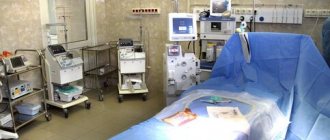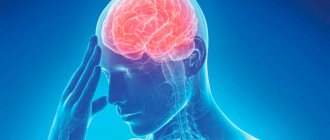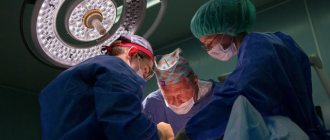Extreme conditions (from the Latin extrema - excessive, extreme, extreme, limit) are usually called severe conditions of the body that arise when it is exposed to particularly pathogenic external factors or the unfavorable development of existing diseases, causing gross disturbances of metabolism and vital functions that pose a threat to life. and requiring urgent active therapeutic intervention.
The concept of “extreme states” should not be confused with the concept of “terminal states”. The main distinguishing feature of terminal conditions is their irreversibility without special emergency medical measures, while many forms of extreme conditions can be independently reversible. Even in cases of an unfavorable outcome during the development of extreme conditions, as a rule, a more or less long period of improvement in the body’s condition is noted - due to the inclusion of numerous compensatory and adaptive mechanisms. Terminal conditions are characterized by progressive depression of functions and extinction of life. Extreme conditions include shock, collapse, coma.
Clinical death: short-term reversible condition
The following signs cause medical staff to sound the alarm:
- loss of consciousness – indicates bleeding of the brain;
- cessation of breathing movements - indicates a lack of oxygen flow into the body;
- cessation of pulse indicates inactivity of the heart muscle.
Secondary symptoms may also include:
- lack of reaction of the pupils to light - this also happens with a powerful electric shock;
- lack of reflex blinking - this happens with temporary paralysis;
- pallor of the skin - this happens with frostbite of the extremities.
Funeral arrangements
in St. Petersburg and the region
Price
holding a funeral
Calling a ritual agent
city funeral service
First of all, the actions of resuscitators are reduced to restoring breathing and blood flow. And the sooner the heart muscle begins to function again, and the lungs supply oxygen to the internal organs, the greater the chance of reviving the patient. Within five minutes, individual brain cells may die. However, during clinical death, the body can turn on its protective functions and enter hyperboric oxygenation. In this state, the available oxygen is slowly consumed, making a return to normal life possible within 10-20 minutes. Slow metabolism can be caused by hypothermia, electric shock, drowning and a number of other reasons.
Visions during clinical death
Ambulance workers and resuscitators deal with patients on the brink of death all the time. Most often, they are brought to life in a brightly lit room. It is the light of the spotlights that hits the eyes with tunnel vision that many patients interpret as “the light at the end of the tunnel.” The silhouettes of doctors trying to bring the dying back to life are perceived as visions from the Kingdom of the Dead, that is, as their deceased relatives. False memories are superimposed on the natural feeling of flight during cerebral ischemia. Together with the influence of medications, chemical reactions occurring inside the body give rise to serious distortion of sensory perceptions. These memories are then interpreted as contacts with the World of Souls.
Pathogenesis
After clinical death occurs, tissue metabolism slows down sharply, but due to anaerobic glycolysis it does not stop completely. When breathing stops and blood flow stops, destruction processes begin very quickly in the body. Due to oxygen starvation, tissues are destroyed. In this case, the cells of the cerebral cortex experience the greatest sensitivity. As a result, when brain cells die, even after successful resuscitation, complete recovery does not occur.
When blood flow stops in the body, active blood clotting occurs, and microthrombi appear in the vessels. Due to toxic products of tissue breakdown entering the blood, metabolic acidosis . With prolonged absence of blood circulation, biological death occurs. In the case of urgent resuscitation, cardiac activity is restored, after which postresuscitation disease as a consequence of ischemia , thrombosis of the capillary network, and significant homeostatic changes.
The duration of the period of clinical death is determined by the period during which the cerebral cortex and subcortex can maintain viability under hypoxic . For 3-5 minutes, the higher parts of the brain can remain viable in the absence of oxygen supply under conditions of normal body temperature. The practice of doctors in all countries of the world indicates that if the specified period is exceeded, then the person can return to life, but in this case the phenomenon of decortication (death of the cerebral cortex) or decerebration (all parts of the brain die) is already noted.
However, in medicine there is a second period of clinical death, which can last longer, after which resuscitation measures allow the person to be revived. This is achieved by the fact that the processes of degeneration of parts of the brain due to hypoxia are slowed down due to the creation of certain conditions. Thus, it is possible to increase the duration of clinical death in a state of hypothermia , that is, artificial cooling of the body. This can also be done by physical influences - hyperbaric oxygenation , head hypothermia . Special pharmacological drugs are also used to ensure a sharp decrease in metabolic processes.
In the absence of resuscitation processes or the failure of such actions, biological death occurs, and all physiological processes in the body cease.
Biological death: irreversible death of cells, tissues, organs
One of the first signs of biological death is the drying of the cornea. It is determined by squeezing the eye from the sides - the pupil then takes the shape of a spindle or “cat’s” eye. It is known to doctors as Beloglazov’s symptom.
Next, the patient begins to exhibit the following symptoms:
- the mucous membranes of the nose, mouth, and genitals dry out;
- body temperature gradually decreases;
- characteristic cadaveric spots appear on the skin;
- rigor mortis is noticeable.
Although decomposition processes begin almost immediately, some organs are less susceptible to it. Thus, the heart can be implanted 1-2 hours after removal from a dead body, and the kidneys and liver can be preserved for about 4 hours. Skin transplantation from a deceased person to a living person can be performed within the first 6 hours. Bone tissue is considered the most resistant - due to its inertness to external factors, it can be implanted into the recipient within 1-2 days.
General information
Clinical death is a transition period between life and biological death of a person.
At its core, it is a reversible stage of death, when the activity of the heart and breathing stops, and no signs of vital activity are observed. Characteristic signs of this condition are the absence of pulse and consciousness, dilated pupils. An objective sign is small-wave atrial fibrillation or isoline on the ECG. However, in this condition, oxygen starvation does not lead to the development of irreversible changes in systems and organs. The ICD-10 code for this condition is G93 (Other brain lesions). Speaking about how long clinical death lasts, it should be noted that the duration of clinical death is no more than 3-4 minutes. The maximum time during which the body can remain in such a terminal state is 5-6 minutes. In rare cases, a longer duration was recorded.
How to identify such a condition and properly provide first aid will be discussed in this article.
Is it possible to confuse clinical and biological death?
Despite numerous media reports about supposedly resurrected people, in reality this happens quite rarely. And in cases of “miraculous” revival, we should talk about the correct resuscitation techniques and the same hyperboric oxygenation that was mentioned earlier. “Resurrections” after a few days or even ten hours are more likely an acted out hoax than the real state of affairs. For it is impossible to prevent or reverse these processes from obvious tissue decay and other signs of decomposition.
Causes
This condition can be caused by a variety of factors - illness, injury. All causes are divided into two groups – those associated with damage to the heart muscle ( cardiac ) and those not associated with it ( non-cardiac ).
Cardiac causes include primary disorders of myocardial contractility, provoked by acute coronary pathology or the influence of toxic substances. Among such causes are acute myocardial infarction , arrhythmias , electrolyte imbalance, rupture of aortic aneurysm, coronary artery disease, etc.
Non-cardiac causes include conditions that accompany the development of severe hypoxia. This can be suffocation, drowning , acute respiratory failure, electric shock, embolism , poisoning, airway obstruction, etc. There is a risk of fibrillation and subsequent cardiac arrest if potassium preparations, cardiac glycosides, antiarrhythmics, barbiturates are administered incorrectly.
Near Death Experiences
For many years, researchers studying the phenomenon of near-death experiences have noted that patients with similar experiences describe similar sensations when returning to life. American psychologist R. Moody paid special attention to this phenomenon.
According to the study, the most common impressions were:
- a feeling of peace and cessation of pain;
- detachment, sometimes the illusion of leaving one’s own body;
- sound effects: buzzing, humming, rustling;
- tunnel vision;
- feeling of flying or floating;
- visions of deceased relatives;
- meetings with mystical characters from whom light emanates;
- footage from a past life;
- lack of desire to return to the earthly world.
Often, patients brought back to life experienced several of the listed impressions at once - from 2 to 6.
Symptoms
The main signs of clinical death of a person are as follows:
- Lack of breathing.
- Lack of effective heart contractions.
- Lack of consciousness.
If these symptoms are present at the same time, this is a clear sign of such a condition.
If the heartbeat or consciousness persists, clinical death is not diagnosed. Within 30 seconds after the blood flow stops, spontaneous residual breathing is possible. Individual myocardial contractions and, accordingly, weak pulse impulses may also be observed. As a rule, no more than 2-5 such shocks are detected.
Speaking about secondary signs of this condition, the following symptoms should be noted:
- Lack of muscle tone, movements, reflexes.
- Unnatural body position.
- Pale sallow skin.
- Inability to determine blood pressure .
- Pupil dilation up to 5 mm without reaction to light (observed after 90 seconds).
- Pointed facial features (the so-called Hippocratic mask).
Speaking about how clinical death differs from biological death, it should be noted that in case of clinical death there is the possibility of resuscitation.
Upon initial superficial examination, signs of clinical and biological death may be similar. However, the definition indicates that biological death is the irreversible cessation of all physiological processes, in contrast to clinical death.
Tests and diagnostics
Speaking about how this condition is diagnosed, first of all, it should be noted that diagnosis and treatment are carried out in parallel. After all, the less time passes between the establishment of such a fact and the start of resuscitation, the greater the likelihood that the person will live a full life subsequently.
This condition is determined by the symptoms described above. But if this happens in a medical institution, additional diagnostic methods are used. They are important in determining how effective methods of resuscitating a patient are. Also, physical and instrumental methods make it possible to assess the degree of hypoxia and acid-base imbalance. During the diagnostic process, measures are simultaneously taken to restore the heart rhythm.
The following types of research can be practiced:
- Physical methods . The examination makes it possible to detect characteristic symptoms. During auscultation, no coronary sounds are heard and there are no breath sounds in the lungs. Visually assess the presence of respiratory movements of the chest. Blood pressure is not determined.
- Instrumental methods . Electrocardiography is performed. It should be taken into account that the isoline corresponding to complete cardiac arrest is not determined in every case. Sometimes there is a random contraction of individual fibers, but there is no blood flow. There are no clear ventricular complexes.
- Laboratory methods . They are used if resuscitation is successful. Biochemical parameters, electrolyte balance, etc. are examined. Metabolic acidosis , high levels of potassium, sodium, proteins, and breakdown products are determined in the blood. Hypocoagulation and decreased concentrations of platelets and coagulation factors are noted.








